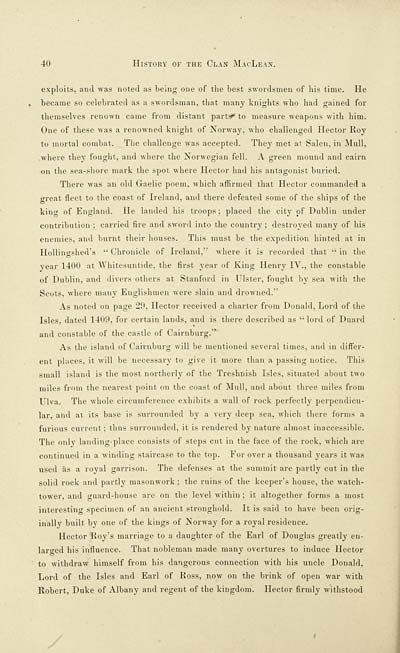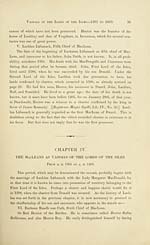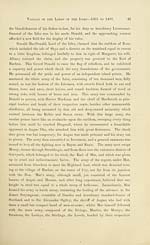History of the Clan MacLean from its first settlement at Duard Castle, in the Isle of Mull, to the present period
(46) Page 40
Download files
Complete book:
Individual page:
Thumbnail gallery: Grid view | List view

40 History of the Clan MacLean.
exploits, and was noted as being one of the best swordsmen of his time. He
became so celebrated as a swordsman, that many knights who had gained for
themselves renown came from distant partsr to measure weapons with him.
One of these was a renowned knight of Norway, who challenged Hector Roy
to mortal combat. The challenge was accepted. They met at Salen, in Mull,
where they fought, and where the Norwegian fell. A green mound and cairn
on the sea-shore mark the spot where Hector had his antagonist buried.
There was an old Gaelic poem, which affirmed that Hector commanded a
great fleet to the coast of Ireland, and there defeated some of the ships of the
king of England. He landed his troops ; placed the city of Dul^lin under
contribution ; carried fire and sword into the country ; destroyed many of his
enemies, and burnt their houses. This must be the expedition hinted at in
HoUingshed's " Chronicle of Ireland," where it is recorded that •' in the
year 1400 at Whitesuntide, the first year of King Henry IV., the constable
of Dublin, and divers others at Stanford in Ulster, fought by sea with the
Scots, where many Englishmen were slain and drowned."
As noted on page 29, Hector received a charter from Donald, Lord of the
Isles, dated 1409, for certain lands, and is there described as "lord of Duard
and constable of the castle of Cairnburg."
As the island of Cairnburg will be mentioned several times, and in differ-
ent places, it will be necessary to give it more than a passing notice. This
small island is the most northerly of the Treshnish Isles, situated about two
miles from the nearest point on the coast of Mull, and about three miles from
Ulva. The whole circumference exhibits a wall of rock perfectly perpendicu-
lar, and at its base is surrounded by a very deep sea, which there forms a
furious current; thus surrounded, it is rendered by nature almost inaccessible.
The only landing-place consists of steps cut in the face of the rock, which are
continued in a winding staircase to the top. For over a thousand years it was
used as a royal garrison. The defenses at the summit are partly cut in the
solid rock and partly masonwork : the ruins of the keeper's house, the watch-
tower, and guard-house are on the level within ; it altogether forms a most
interesting specimen of an ancient stronghold. It is said to have been orig-
inally built by one of the kings of Norway for a royal residence.
Hector Roy's marriage to a daughter of the Earl of Douglas greatly en-
larged his influence. That nobleman made many overtures to induce Hector
to withdraw himself from his dangerous connection with his uncle Donald,
Lord of the Isles and Earl of Ross, now on the brink of open war with
Robert, Duke of Albany and regent of the kingdom. Hector firmly withstood
exploits, and was noted as being one of the best swordsmen of his time. He
became so celebrated as a swordsman, that many knights who had gained for
themselves renown came from distant partsr to measure weapons with him.
One of these was a renowned knight of Norway, who challenged Hector Roy
to mortal combat. The challenge was accepted. They met at Salen, in Mull,
where they fought, and where the Norwegian fell. A green mound and cairn
on the sea-shore mark the spot where Hector had his antagonist buried.
There was an old Gaelic poem, which affirmed that Hector commanded a
great fleet to the coast of Ireland, and there defeated some of the ships of the
king of England. He landed his troops ; placed the city of Dul^lin under
contribution ; carried fire and sword into the country ; destroyed many of his
enemies, and burnt their houses. This must be the expedition hinted at in
HoUingshed's " Chronicle of Ireland," where it is recorded that •' in the
year 1400 at Whitesuntide, the first year of King Henry IV., the constable
of Dublin, and divers others at Stanford in Ulster, fought by sea with the
Scots, where many Englishmen were slain and drowned."
As noted on page 29, Hector received a charter from Donald, Lord of the
Isles, dated 1409, for certain lands, and is there described as "lord of Duard
and constable of the castle of Cairnburg."
As the island of Cairnburg will be mentioned several times, and in differ-
ent places, it will be necessary to give it more than a passing notice. This
small island is the most northerly of the Treshnish Isles, situated about two
miles from the nearest point on the coast of Mull, and about three miles from
Ulva. The whole circumference exhibits a wall of rock perfectly perpendicu-
lar, and at its base is surrounded by a very deep sea, which there forms a
furious current; thus surrounded, it is rendered by nature almost inaccessible.
The only landing-place consists of steps cut in the face of the rock, which are
continued in a winding staircase to the top. For over a thousand years it was
used as a royal garrison. The defenses at the summit are partly cut in the
solid rock and partly masonwork : the ruins of the keeper's house, the watch-
tower, and guard-house are on the level within ; it altogether forms a most
interesting specimen of an ancient stronghold. It is said to have been orig-
inally built by one of the kings of Norway for a royal residence.
Hector Roy's marriage to a daughter of the Earl of Douglas greatly en-
larged his influence. That nobleman made many overtures to induce Hector
to withdraw himself from his dangerous connection with his uncle Donald,
Lord of the Isles and Earl of Ross, now on the brink of open war with
Robert, Duke of Albany and regent of the kingdom. Hector firmly withstood
Set display mode to:
![]() Universal Viewer |
Universal Viewer | ![]() Mirador |
Large image | Transcription
Mirador |
Large image | Transcription
Images and transcriptions on this page, including medium image downloads, may be used under the Creative Commons Attribution 4.0 International Licence unless otherwise stated. ![]()
| Histories of Scottish families > History of the Clan MacLean from its first settlement at Duard Castle, in the Isle of Mull, to the present period > (46) Page 40 |
|---|
| Permanent URL | https://digital.nls.uk/94802435 |
|---|
| Description | A selection of almost 400 printed items relating to the history of Scottish families, mostly dating from the 19th and early 20th centuries. Includes memoirs, genealogies and clan histories, with a few produced by emigrant families. The earliest family history goes back to AD 916. |
|---|

